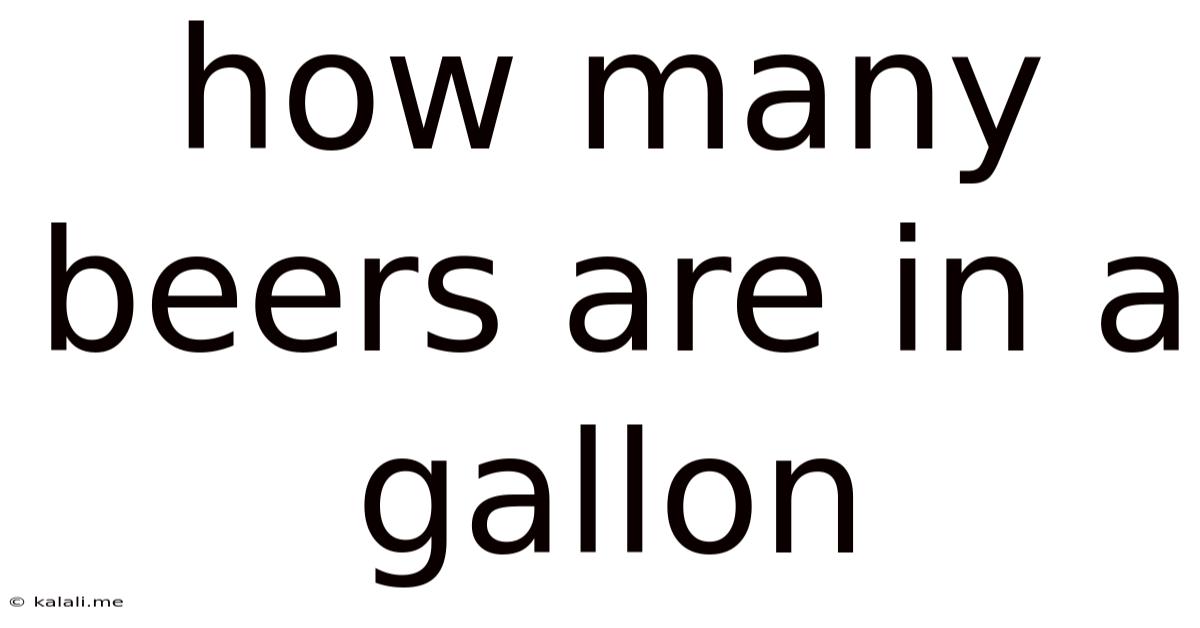How Many Beers Are In A Gallon
Kalali
Aug 23, 2025 · 4 min read

Table of Contents
How Many Beers Are in a Gallon? A Comprehensive Guide to Beer Volume
Ever wondered how many beers fit into a gallon? It's a question that might seem simple at first, but delves into the fascinating world of beer measurements, serving sizes, and even a touch of mathematical estimation. This comprehensive guide will explore this question in detail, considering various bottle and can sizes, offering helpful calculations, and addressing potential misconceptions. Understanding this seemingly simple conversion can be surprisingly useful for planning parties, stocking bars, or even just satisfying your curiosity about liquid volumes.
Understanding the Variables: More Than Just a Simple Calculation
The seemingly straightforward question, "How many beers are in a gallon?" doesn't have a single, definitive answer. The number of beers varies significantly depending on a few key factors:
-
Bottle/Can Size: Beer comes in a wide range of container sizes. Standard options include 12-ounce bottles, 16-ounce pint cans, and even larger sizes like 22-ounce bombers and 32-ounce growlers. Each size drastically alters the final count.
-
Definition of a "Beer": Are we talking about a standard 12-ounce serving? Or are we including different sizes, like the aforementioned bombers or pints? This ambiguity necessitates clarification before any accurate calculation can be made.
-
Liquid Measurement Precision: While we'll use standard U.S. liquid measurements (gallons and ounces), variations in filling processes might lead to slight inconsistencies in the actual volume of each individual container.
Calculations for Common Beer Container Sizes
Let's break down the calculations for the most common beer container sizes. Remember, a U.S. liquid gallon contains 128 fluid ounces.
1. 12-Ounce Bottles:
This is the most prevalent size for standard beer bottles. The calculation is straightforward:
128 fluid ounces (per gallon) / 12 fluid ounces (per bottle) = 10.67 bottles per gallon
Rounding down, you can fit approximately 10 twelve-ounce bottles into a gallon. The remaining 8 ounces represent roughly two-thirds of another bottle.
2. 16-Ounce Pint Cans:
Pint cans, increasingly popular, change the calculation:
128 fluid ounces (per gallon) / 16 fluid ounces (per can) = 8 cans per gallon
This equates to a clean and even 8 sixteen-ounce cans per gallon.
3. 22-Ounce Bomber Bottles:
Bomber bottles, often used for higher-quality or specialty beers, alter the calculation significantly:
128 fluid ounces (per gallon) / 22 fluid ounces (per bomber) = 5.82 bombers per gallon
Rounding down, you'll get roughly 5 22-ounce bombers in a gallon, leaving a little less than a sixth of a bomber's worth of space.
4. 32-Ounce Growlers:
Growlers, designed for filling from a tap, result in a smaller number:
128 fluid ounces (per gallon) / 32 fluid ounces (per growler) = 4 growlers per gallon
This gives you exactly 4 32-ounce growlers per gallon.
Beyond the Basics: Considering Variations and Practical Implications
The calculations above represent idealized scenarios. In reality, factors like:
-
Headspace: Many beer bottles and cans leave some headspace at the top, meaning the actual liquid volume might be slightly less than the stated capacity.
-
Temperature: Beer volume can slightly change with temperature fluctuations.
-
Packaging Variations: Slight discrepancies in manufacturing can lead to variations in the actual amount of beer within each container.
These factors mean the calculated numbers should be considered approximate rather than exact. Don't expect to perfectly fill a gallon jug with precisely 10 twelve-ounce bottles.
Practical Applications and Planning:
Understanding the relationship between beer volume and gallons is valuable for:
-
Party Planning: Estimating how much beer to buy for a gathering becomes much easier once you know the number of beers per gallon and can adjust based on the expected consumption per person.
-
Bar Stocking: Restaurant and bar owners can use these calculations for efficient inventory management and cost control.
-
Homebrewing: Homebrewers might use gallon measurements to plan their batches and understand yield.
-
Keg Calculations: While not directly related to bottles or cans, understanding the volume in gallons helps in calculating the number of servings from a keg.
Expanding the Scope: Metric Conversions and International Variations
While the calculations above focus on U.S. customary units, many parts of the world use the metric system. A liter is approximately 33.8 fluid ounces. Therefore, you can perform similar calculations using liters as your base unit to determine beer volume. The most common beer bottle sizes in metric are 330ml (approximately 11.2 ounces) and 500ml (approximately 16.9 ounces).
Different countries have different standard beer bottle and can sizes, influencing the number of beers per gallon or liter equivalent. This necessitates adjusting the calculations based on the specific sizes available in each region.
Conclusion: A Deeper Dive into Beer Math
The seemingly simple question of "How many beers are in a gallon?" opens a door to a surprising amount of detail. Understanding the impact of different container sizes, accounting for potential variations, and applying the calculations to practical situations highlights the importance of precise measurement and planning, especially in areas like party planning, bar management, and homebrewing. By understanding these calculations and their limitations, you can approach beer-related volume estimations with increased accuracy and confidence. Now go forth and confidently plan your next gathering! Remember to always drink responsibly.
Latest Posts
Latest Posts
-
How Heavy Is 3 Liters Of Water
Aug 23, 2025
-
69 Out Of 75 As A Percentage
Aug 23, 2025
-
How Does Doodle Die In The Scarlet Ibis
Aug 23, 2025
-
Song Titles With References To Something Circular
Aug 23, 2025
-
45 Years Ago What Year Was It
Aug 23, 2025
Related Post
Thank you for visiting our website which covers about How Many Beers Are In A Gallon . We hope the information provided has been useful to you. Feel free to contact us if you have any questions or need further assistance. See you next time and don't miss to bookmark.